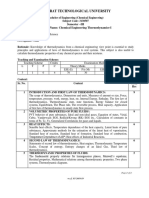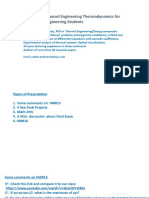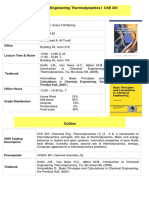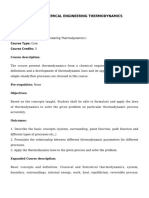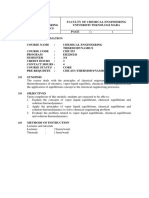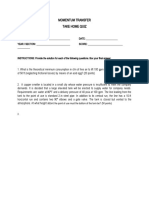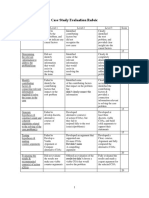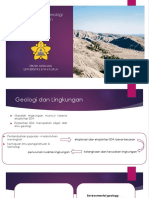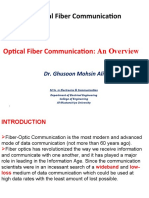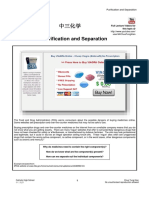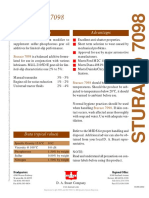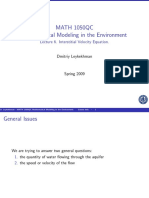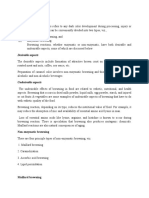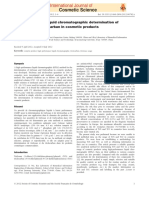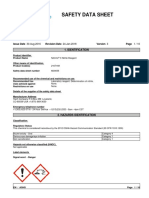Chemical Engineering Department
School Year 2017 - 2018
1. Course and Instructor Information
College: Engineering
Department: Chemical Engineering
Course Title: ChE Thermodynamics 1
Course Code: CH414
Pre-Requisite: Applied ChE Math 1, Physical Chemistry for Engineers 1
Pre-Requisite To: ChE Thermodynamics 2
Credit Units: 3
Instructor/s: Engr. Patrick Luis Z. Soriano/Engr. Robert Delfin
2. Course Description
This course deals with the applications of the 1st and 2nd laws of thermodynamics to closed
and open systems, volumetric properties of pure substances, the use of phase diagrams and
thermodynamic tables, applications of equations of state for ideal and non-ideal fluids.
3. Course Outcomes
Graduate Attributes Student Outcomes Course Outcomes
SO-a: Ability to apply CO1: Identify and describe the
knowledge of mathematics
thermodynamic systems using
Creative and Critical Thinking: and science to solve thermodynamics properties
A critical thinker who can engineering problems.
define, identify and evaluate CO 2: Apply the laws of
problems in the workplace and thermodynamics to solve
can innovate, create and SO-e Ability to identify, problems on processes related to
formulate solutions to formulate, and solve Chemical Engineering
problems, and advance engineering problems CO : Analyze the
knowledge.
thermodynamic systems to be
able to derive important
equations based on the given
conditions
CH 414 Date Effective: Date Revised: Prepared by: Reviewed by: Approved by: Page 1 of
11
Chemical June 2017 June 2017 Engr. Patrick Engr. Erison C. Engr. Evelyn
Engineering Luis Z. Roque Q. Raguindin
Thermodynamics Soriano
1
� Chemical Engineering Department
School Year 2017 - 2018
4. Course Assessment Matrix
STUDENT OUTCOMES
COURSE OUTCOMES A B C D E F G H I J K
CO 1: Identify and describe the
thermodynamic systems using
thermodynamics properties 2
CO 2: Apply the laws of
thermodynamics to solve problems 2
on processes related to Chemical
Engineering
CO 3: Analyze the 2
thermodynamic systems to be able
to derive important equations
based on the given conditions
1- Introductory, 2 – Enabling, 3 – Demonstrative
5. Final Course Output
As evidence of attaining the above learning outcomes (LO), the student is required to accomplish
and submit the following during the indicated period/dates within the term:
COURSE
REQUIRED OUTPUT DUE DATE
OUTCOMES (CO)
Analyze and present The term-end project requires team work. Each team Final two weeks of
logical methods of selects a particular industry and identify a certain the semester
solution to various energy cycle. The report includes the following:
chemical engineering
- Process energy cycle
problems - Process energy cycle description
- Complete energy balance
CO 3: Analyze the
thermodynamic Each student will do a journal review and critique.
systems to be able to This will be reported in class. Also a written review
and critique will be submitted.
derive important
equations based on the
given conditions
CH 414 Date Effective: Date Revised: Prepared by: Reviewed by: Approved by: Page 2 of
11
Chemical June 2017 June 2017 Engr. Patrick Engr. Erison C. Engr. Evelyn
Engineering Luis Z. Roque Q. Raguindin
Thermodynamics Soriano
1
� Chemical Engineering Department
School Year 2017 - 2018
6. Rubrics
RUBRIC FOR ASSESSMENT OF THE TERM-END PROJECT:
EXCEEDS MEETS BELOW
NOT ACCEPTABLE
EXPECTATION EXPECTATION EXPECTATION
CRITERIA
4 1
3 2
Understood and Understood and Understood and Understood and
identified the identified the given identified the given identified the given
given and required and required of the and required of the in the problem.
of the problem; problem and was problem and was
was able to draw able to draw the able to draw the
the correct correct schematic correct schematic
schematic diagram. diagram.
Understandin
diagram; was able
g the
to derive the
problem
equations needed
(30%)
to solve the
problem together
with valid
assumptions and
limitations of the
use of the derived
equations.
A complete A complete A partially correct Totally
solution was solution was procedure of inappropriate
presented in a presented in a solutions but with direction of
logical manner logical manner and major fault on solutions.
and final answers final answers with appropriate units
with appropriate appropriate units and/or
units and and dimensions manipulations of
dimensions mathematical
Solving the
together with the equations with no
Problem
limitation and or wrong final
(70%)
possible sources of answer.
deviation from
reality the
generated solution
and how such
deviations can be
minimized or
eliminated.
CH 414 Date Effective: Date Revised: Prepared by: Reviewed by: Approved by: Page 3 of
11
Chemical June 2017 June 2017 Engr. Patrick Engr. Erison C. Engr. Evelyn
Engineering Luis Z. Roque Q. Raguindin
Thermodynamics Soriano
1
� Chemical Engineering Department
School Year 2017 - 2018
7. Rubrics Transmutation Scores
8. Learning Plan
TEACHING
INTENDED
AND
COURSE LEARNING TOPIC WEEK ASSESSMENT
LEARNING
OUTCOME OUTCOMES
ACTIVITIES
LO 1: Establish
Orientation and
some basic
CO 1 Introduction to the Course Lecture Seatwork
terminologies
CO 2 and principles of Course Syllabus Board work Problem Set
thermodynamics
CO 3 Definition of 1-4
Thermodynamics
LO 2: Identify INTRODUCTION
and describe the 1. Scope of
thermodynamic Thermodynamics
systems 2. Macroscopic and
Microscopic Approach
LO 3: Interpret 3. Dimensions and Units
the different Force
diagrams used in Pressure
thermodynamics Work
Power
LO 4:
Heat
Differentiate and Energy
solve ideal and 4. Terminologies
non-ideal fluid Systems and
problems Surroundings
State of System
CH 414 Date Effective: Date Revised: Prepared by: Reviewed by: Approved by: Page 4 of
11
Chemical June 2017 June 2017 Engr. Patrick Engr. Erison C. Engr. Evelyn
Engineering Luis Z. Roque Q. Raguindin
Thermodynamics Soriano
1
� Chemical Engineering Department
School Year 2017 - 2018
Thermodynamic
Equilibrium
Boundary Wall
Thermodynamic
Processes
Properties
5. Temperature and the
Zeroth Law of
Thermodynamics
6. State and Path Functions
7. Phase Rule
VOLUMETRIC
PROPERTIES OF PURE
FLUIDS
1. Phase Changes of Pure
Substances
2. PVT Behavior of Pure
Substances
3. Equation of State
4. Equation of State for
Ideal Gas
5. Equation of State for Real
Gas
Cubic Equation of State
Redlich-Kwong
Equation of State
Redlich-Kwong-Soave
Equation of State
Peng-Robinson
Equation of State
Beattie-Bridgeman
Equation of State
Virial Equations of
State
6. Compressibility Factors
7. Generalized Correlations
for Gases
8. Generalized Correlations
for Liquids
THE FIRST LAW AND
OTHER BASIC
CONCEPTS
1. Joule's Experiment
2. Statement of the First
CH 414 Date Effective: Date Revised: Prepared by: Reviewed by: Approved by: Page 5 of
11
Chemical June 2017 June 2017 Engr. Patrick Engr. Erison C. Engr. Evelyn
Engineering Luis Z. Roque Q. Raguindin
Thermodynamics Soriano
1
� Chemical Engineering Department
School Year 2017 - 2018
Law of Thermodynamics
3. Internal Energy
4. Heat and Work
Interactions
5. The First Law of
Thermodynamics for
Cyclic and Closed
System
6. Mass and Energy Balance
for Closed System
LONG EXAM 1
THE FIRST LAW AND
OTHER BASIC 5-6
LO 5: State and CONCEPTS Lecture Seatwork
explain the First (Continuation)
Law of Board work Problem Set
Thermodynamics 1. Thermodynamic State
to be able to and State Functions
derived its 2. Internal Energy of an
mathematical Ideal Gas
CO 1 expression 3. Thermodynamic State
4. State Function
CO 2 LO 6: Recognize 5. Enthalpy
and analyze 6. Heat Capacity
CO 3 different 7. Constant-V and Constant-
processes P Processes
8. Adiabatic Process
9. Reversible Adiabatic
Expansion of Ideal Gas
10. Mass and Energy
Balances for Open
Systems
LONG EXAM 2
HEAT EFFECTS
1. Exothermic and
LO 7:Define and 7-9 Lecture Seatwork
Endothermic Reactions
CO 1 explain the
2. Sensible Heat Effects Board work Problem Set
meaning of
3. Hess’s Law of Constant
CO 2 exothermic and
Heat Summation
endothermic
CO 3 4. Latent Heats of Pure
reactions, Hess’s
Substances
Law and Heat
5. Standard Heat of
effects.
Reaction
CH 414 Date Effective: Date Revised: Prepared by: Reviewed by: Approved by: Page 6 of
11
Chemical June 2017 June 2017 Engr. Patrick Engr. Erison C. Engr. Evelyn
Engineering Luis Z. Roque Q. Raguindin
Thermodynamics Soriano
1
� Chemical Engineering Department
School Year 2017 - 2018
6. Standard Heat of
Formation
7. Standard Heat of
Combustion
8. Temperature
Dependence: Kirchoff’s
Equation
LONG EXAM 3
LO 8: State and THE SECOND AND 10-12 Lecture
Seatwork
discuss the Second THIRD LAW OF
and Third Law of THERMODYNAMICS Board work Problem Set
Thermodynamics 1. Limitations of the First
and deduce the Law
mathematical
2. Heat Engines
expression for the
second and third 3. Statements of the Second
law. Law
Kelvin-Planck
Statement
Clausius Statement
Equivalence of Kelvin-
Planck and Clausius
Statement
CO 1 4. Thermodynamic
Temperature Scales
CO 2 5. Entropy
6. Entropy Changes of an
CO 3
Ideal Gas
7. Mathematical Statement
of the Second Law
8. Entropy Balance for
Open Systems
9. Calculation of Ideal
Work
10. Lost Work
11. The Third Law of
Thermodynamics
12. Entropy from the
Microscopic Viewpoint
13. Criterion for
Irreversibility
LONG EXAM 4
CH 414 Date Effective: Date Revised: Prepared by: Reviewed by: Approved by: Page 7 of
11
Chemical June 2017 June 2017 Engr. Patrick Engr. Erison C. Engr. Evelyn
Engineering Luis Z. Roque Q. Raguindin
Thermodynamics Soriano
1
� Chemical Engineering Department
School Year 2017 - 2018
Lecture Seatwork
THERMODYNAMIC 13-15
LO 9: Explain the Board work Problem Set
PROPERTIES OF
free energy
functions and its
FLUIDS
importance 1. Free Energies
Helmholtz Free
LO 10: Establish Energy
Maxwell’s relation Gibb’s Free Energy
from the Variation of Free
thermodynamic Energy with Pressure
property relations at Constant
CO 1 2. Thermodynamic Property
Relations
CO 2
Fundamental Property
CO 3 Relations
Maxwell’s Relations
Clapeyron Equation
Gibbs-Helmholtz
Equation
Heat Capacity
Relations
3. Isothermal
Compressibility and
Volume Expansivity
4. Joule-Thomson Effects
LONG EXAM 5
LO 11: RESIDUAL PROPERTIES 16-17 Lecture Seatwork
Differentiate and OF FLUIDS
Board work Problem Set
evaluate the 1. Residual Property
CO 1 residual 2. Residual Property from
properties from Equation of State
CO 2 the knowledge of 3. Residual Property from
Virial Equation of State
CO 3 equation of state,
4. Residual Property from
virial equation
CEOS
and CEOS 5. Fugacity and Fugacity
Coefficient
LO 12: Apply
Thermodynamics APPLICATIONS OF
to flow processes THERMODYNAMICS TO
FLOW PROCESSES
1. Steady Flow Process and
Devices
Duct Flow of
CH 414 Date Effective: Date Revised: Prepared by: Reviewed by: Approved by: Page 8 of
11
Chemical June 2017 June 2017 Engr. Patrick Engr. Erison C. Engr. Evelyn
Engineering Luis Z. Roque Q. Raguindin
Thermodynamics Soriano
1
� Chemical Engineering Department
School Year 2017 - 2018
Compressible Fluids
Throttling Devices
Ejectors and Jet
Pumps
Turbines (Expanders)
Compression
Processes
Nozzles and
Diffusers
2. Unsteady-flow and Devices
Control Volume
Analysis
LONG EXAM 6
Comprehensive Final Examination
CH 414 Date Effective: Date Revised: Prepared by: Reviewed by: Approved by: Page 9 of
11
Chemical June 2017 June 2017 Engr. Patrick Engr. Erison C. Engr. Evelyn
Engineering Luis Z. Roque Q. Raguindin
Thermodynamics Soriano
1
� Chemical Engineering Department
School Year 2017 - 2018
9. Other Requirements and Assessments
The student will also be assessed by the following:
Problem Set
Comprehensive Examination (Removal)
Journal Review and Critique
10. Grading System
Term Grade = 45% LE1 + 45% LE2 + 10% Other Requirement
Semestral Grade (FG) = 30% Prelim Grade+ 30% Midterm Grade + 40% Final Term Grade
Semestral Grade Point
Grade Equivalent
97 – 100 1.00
93 – 96 1.25
89 – 92 1.50
85 – 88 1.75
82 – 84 2.00
79 – 81 2.25
76 – 78 2.50
73 – 75 2.75
70 – 72 3.00
<70 5.00
11. Textbooks
Smith, J. M, Van Ness, H C , and Abbott, M. M , Introduction to Chemical
Engineering Thermodynamics 7th Edition. Mc-Graw Hill Co. Inc., 2002.
12. References
1. Smith, J. M, Van Ness, H C , and Abbott, M. M , Introduction to Chemical
Engineering Thermodynamics 7th Edition. Mc-Graw Hill Co. Inc., 2002.
2. Borgnakke, C., Sonntag, R. E.., Wylen, G.J.V., Fundamentals of Thermodynamics, 7th
Edition, Wiley, Hoboken, NJ, 2009
CH 414 Date Effective: Date Revised: Prepared by: Reviewed by: Approved by: Page 10 of
11
Chemical June 2017 June 2017 Engr. Patrick Engr. Erison C. Engr. Evelyn
Engineering Luis Z. Roque Q. Raguindin
Thermodynamics Soriano
1
� Chemical Engineering Department
School Year 2017 - 2018
3. Cengel, Y.A., Thermodynamics: An Engineering Approach, McGraw-Hill,
Singapore, 2011
4. Hayne, D.T., Biological Thermodynamics, Cambridge University Press, NY, 2008
5. Lukas, H.L., Fries, S.G., Sundman, B., Computational Thermodynamics: The
Calphad Method, Cambridge University Press, NY, 2008
6. Roy, B. N., Fundamentals of Classical and Statistical Thermodynamics, John Wiley
& Sons Ltd., Chicester, UK, 2002.
7. Shavit, A., Gutfinger, C., Thermodynamics: from concepts to applications, CRC
Press, Boca Raton, 2009
12. Classroom Policies
1. University policy on attendance and uniform will strictly be implemented.
2. When there is a need, use of electronic gadgets will be allowed during class.
3. Special examination will be granted based on the reason stipulated in the Student Manual.
4. Cheating acts include but are not limited to: Writing formulas in Perry’s handbook (including
erased but visible formulas), possession of unauthorized materials during exams, and acts described
in the Student Manual. Once caught in any form of cheating would result to a grade of 0 for that
particular exam in the first offense and a grade of 5.0 in this course in the second offense.
CH 414 Date Effective: Date Revised: Prepared by: Reviewed by: Approved by: Page 11 of
11
Chemical June 2017 June 2017 Engr. Patrick Engr. Erison C. Engr. Evelyn
Engineering Luis Z. Roque Q. Raguindin
Thermodynamics Soriano
1














